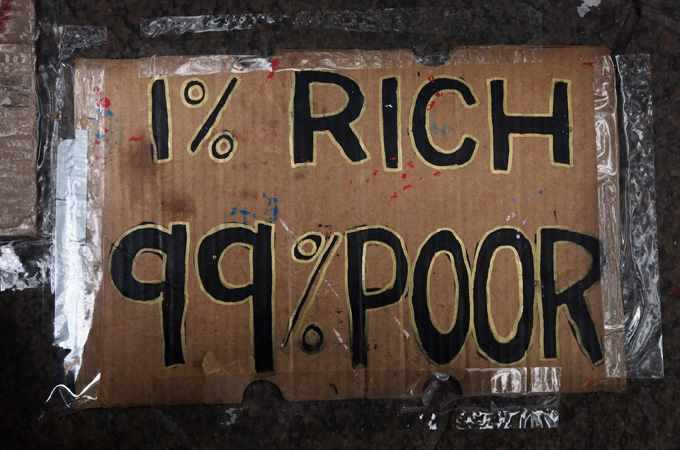Occupy Wall Street: ‘We are the 99%’
Leaderless protest movement targeting economic inequality starts in New York and quickly goes global in our No. 6.

 |
| Protests against capitalism, corruption and corporate greed have spread around the world [GALLO/GETTY] |
The year 2011 witnessed two of the biggest mass movements in recent history – the Arab Awakening and the Occupy Wall Street movement.
But while the Arab Awakening cut short the half-life of despotic rulers in the Middle East and North Africa, the Wall Street movement focused less on a leader and more on the global hegemony of multinational corporations and giant banks.
The idea to “occupy” Wall Street – the US financial hub located in New York City – was first floated in July 2011 by the people behind Adbusters, a counter-culture magazine based in Vancouver, Canada, who called for peaceful action against corporate influence on democracy.
The idea became a trending topic that went viral on Twitter and Facebook, and a buzzword for thousands who took to the streets across the world against what they called unfair wealth distribution and corporate-political nexus.
The protests began in September in Zuccotti Park, located in the heart of New York’s financial district. Within a month, they had spread to more than 100 cities in the US.
Much of the media initially mocked the Occupy protesters as a collection of kooky characters, anarchists and hippies, with no clear agenda. But as city after city erupted with demonstrations, it became clear that the movement would not be as short-lived as some once thought.
Hundreds of people were arrested in New York, Oakland, Washington, Los Angeles, Philadelphia and various other US cities as student groups, trade unions, and women’s groups joined the protests.
The slogan “we are the 99 per cent” became an anthem for the protesters, as it attacked the root of wealth inequality between what activists said was the wealthiest one per cent and the remaining 99 per cent of the population.
Wall Street, the nerve centre of global financial institutions blamed for creating an economic collapse, became an obvious symbol of that target.
However, the movement soon morphed into “Occupy Everywhere” as people in more than 1,000 cities in about 100 countries took to the streets demanding better pay, jobs, an end to corruption and greed and above all, better economic conditions.
The global movement has included protests in Tokyo and Melbourne, Frankfurt and Nairobi and several eurozone countries on economic life-support (Greece, Italy, Spain and Portugal) also witnessed massive street protests in the wake of hefty austerity measures.
Slavoj Zizek, the Slovenian-born philosopher, told Al Jazeera in November that “the marriage between capitalism and democracy is over”.
While the evidence of such a statement may be up for debate, what is clear is that the discontent among thousands of people around the world is unlikely to dissipate in 2012.